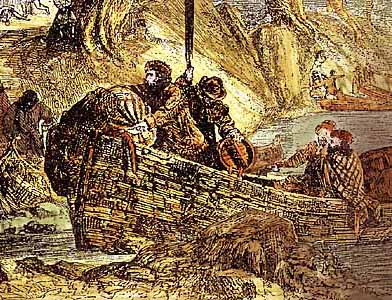

In the 1600s and 1700s, fur hats were popular in
Europe. North America became the source of beaver, muskrat,
deer, and raccoon pelts for the hat industry in Europe. These
animals were trapped and hunted by Native Americans in return
for trade goods and by French voyageurs![]() * in
return for money and goods. The pelts were sorted, graded, and
bought by merchants who shipped them to Europe. Pelts of beaver
and raccoon provided the raw material out of which men's top
hats were made. When the silk top hat was created by Italian
hatmakers in the late 1700s, the fur trade greatly
declined.
* in
return for money and goods. The pelts were sorted, graded, and
bought by merchants who shipped them to Europe. Pelts of beaver
and raccoon provided the raw material out of which men's top
hats were made. When the silk top hat was created by Italian
hatmakers in the late 1700s, the fur trade greatly
declined.
© Illinois State Museum 31-Dec-96